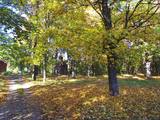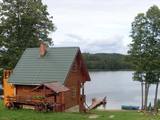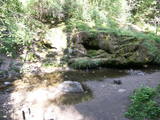| Нo | Название | Описание |
|---|---|---|
|
В хозяйстве создана современнейшая в Балтии кроличья ферма. Кролики живут в кроличьих баньках, а снаружи – в смотровых вольерах. Дети могут познакомиться с 24 породами кроликов и осмотреть окрестности со смотровой вышки. По предварительной договоренности – покупка свежей крольчатины, колбас, копченостей и паштета. Новинка – венгерские дикие свини Мангалица. |
||
|
Часовня усадьбы Пуша – местный памятник архитектуры,
построенный в 18 веке. Находится в парке усадьбы Пуша. Парк разбит
в середине 19 века и является национальным памятником архитектуры.
|
||
|
Lauku māja atrodas Alksnis ezera krastā Aukštaitijas nacionālajā parkā. Ezers ir savienots ar pārējiem ezeriem, kas iekļaujas šinī parkā. Šī vieta ļoti piemērota makšķerniekiem un tiem, kuriem patīk baudīt mieru. Plaša viesistaba ar kamīnu, 2 guļamistabas, atsevišķs pirts namiņš, vieta ugunskuram, laivas nomai. |
||
|
Хутор Maizes māja возле Цесиса ‒ это место, которое подарит радость, силы и научит полезным в жизни навыкам! Здесь проводятся застолья с пирогами и мероприятия по выпеканию хлеба. В Доме хлеба школьники, семьи, группы друзей и туристов на время становятся одной семьей, в которой много работы – носить дрова, топить печь, а в настоящей дровяной печи выпекается ржаной черный хлеб или кисло-сладкий хлеб из ржаной муки «Каупо». Когда все дела переделаны, семья садится за общий стол. Tакже посетителям предлагают ознакомиться с профессией пекаря, кулинара и повара, приобрести жизненные навыки, испытать всевозможные приключения на лоне природы, отметить традиционные праздники и праздники времен года, провести торжество в старинном амбарчике. |
||
|
Observatory which was built (1808. – 1810. g.) Southeast of Doma Hill is called pearl of Estonian's science. There's a museum inside. |
||
|
SIA "Limbažu Tīne" ir vilnas pārstrādes uzņēmums ar senām mājas tekstila tradīcijām, kas dibināts jau 1914. gadā. Šobrīd uzņēmumā tiek ražota vilnas dzija, austi augstvērtīgi vilnas un linu audumi, segas, parklāji, pledi, galdauti, dvieļi, lakati un citi tekstilizstrādājumi. Limbažu Tīne ražo etnogrāfiskos audumos pēc autentiskajām Baltijas reģiona kultūrvēsturiskā mantojuma paraugiem. |
||
|
Beķereja, veikals un kafejnīca atrodas Vaiņodes centrā. Saimniece cep pīrāgus, cepumus un plātsmaizes Latgales meistara mūrētā maizes krāsnī, gatavo tradicionāli latviskus ēdienus, klāj svētku galdus. Beķerejas veikalā var iegādāties ceptuves gardumus un uzzināt par apkaimes interesantākajām vietām. Par dienas aktuālo piedāvājumu beķerejas saimniece ziņo facebook.com/ineta.zveja . |
||
|
В горнице «Agluona», находящейся в усадьбе, выпекают домашний хлеб, домашние пироги Малой Литвы, вафли, готовят кафию, можно попробовать и другие блюда региона Малой Литвы и Жямайтии. Также проводятся дегустации. |
||
|
Находится в Этнографическом музее Латвии под открытым небом. Обустроена висторической корчме, которая из Вецумниеки перевезена в музей, сохранив сквозной вертикальный дымоход над очагом (апвалкдуменис), печь для выпечки хлеба и др. Питание можно объединить с участием в коллективе народной музыки и ремесленничества. Организуют «Латышскую свадьбу». Латышская кухня: Бутерброды с килькой, минога, фаршированная щука, луковый клопс, бычьи яйца в сметанном соусе, приготовленный на гриле поросенок, деревенский хлеб, испеченный самими деревенский хлеб, на костре сваренный суп, блины. Особое блюдо: Жаркое в брусничном соусе от корчмы «Приедес крогс». |
||
|
Число голов – около 50, они все пасутся на улице, поэтому осмотреть их можно в любое время. При возможности посетители могут попробовать мясо породы Хайленд. Также посетители могут осмотреть жямайтукасов и покататься на них. Экскурсии больше рекомендованы для взрослых лиц. |
||
|
Сказительница, передающая язык вентиней, и травница Лига Рейтере в классе старинной школы обучает чистописанию и диалекту вентиней. Параллельно с познавательной экскурсией можно приобрести сделанные в Курземе товары и сувениры. |
||
|
Vecpiebalgas vecajos kapos (Vecpiebalgas austrumdaļā, pa ceļam uz "Saulrietiem" un "Vēveriem") apskatāms piemineklis, kas veltīts brāļu Kaudzīšu romāna "Mērnieku laiki" personāžam - Lienai. Piemineklis uzstādīts 1987. g. (tēlniece M. Baltiņa). Pirms ceļojuma atkal ir jāpāršķirsta "Mērnieku laiki"! |
||
|
This is the 11th largest Estonian island, and its central section is covered by a broadleaf forest (linden, oak, elm and other trees) that is more than 100 years old. Along the shores, the Abruka Island has meadows and small areas of wetlands. Only the northern part of the island is populated. Few tourists come to call, which means that the island is relatively untouched by humankind.
|
||
|
This is the thickest English oak (Quercus robur) in Lithuania, with a circumference of 9.4 m (as opposed to the Kaive oak in Latvia, which has a circumference of 10.18 m).
|
||
|
Расположен на территории Даугмале, которую омывают воды Даугавы. Благодаря этому пчелы могут собрать и принести высококачественный мед, который неоднократно завоевывал признание на латвийских конкурсах, а также другие продукты пчеловодства. |
||
|
О строительстве порта К. Валдемарс мечтал уже с ранней юности, как говорят – еще будучи ребенком! Но только в начале 20-го века в Рое был создан так называемый порт укрытия – построенная в море защитная дамба в 0,5 км от берега протяженностью ~ 213 м. Но она постепенно разрушалась и полностью была разрушена в 1933-м году. В 1930-х годах были начаты работы по выпрямлении русла реки Роя, используя землечерпалку «Рапулис», произведенную во Франции. Были насыпаны валы, построены каменные дамбы и свайные молы, которые позже несколько раз удлинялись. В 1932-м году рыбаки сами своими силами построили мол протяженностью 107 м. Реконструкция портового мола полностью была завершена в 1972-м году. Когда-то здесь, объединив прибрежные рыбацкие хозяйства, активно действовал рыболовецкий колхоз «Банга». (Источник: Ройский ТИЦ) |
||
|
В хозяйстве производят продукты переработки молока и выращивают клубнику. Гостям предлагается освоить навыки выпечки ржаного хлеба, приготовить сыр и мороженое домашним способом и увидеть животных (овец, коз, свиней, телят, коров, лошадей, кур, кроликов, морских свинок и др.). Энтузиасты могут попробовать свои силы на сельскохозяйственных работах. Дегустация и приобретение продукции. |
||
|
Saimniecība “Lejaskroķi” atrodas Abavas senlejā. Tajā nodarbojas ar truškopību. Saimnieku aprūpē ir ap 500 trušu, kā arī kazas un mājputni. Viesojoties saimniecībā, viesi varēs samīļot un pabarot trusīšus, kā arī apskatīt kazlēnus, kam ļoti patīk cilvēku uzmanība. Dzīvnieciņus iespējams apskatīt, iepazīt un samīļot, kā arī pabarot. |
||
|
Die im 19. Jh. gebauten Mühlen sind vollständig renoviert. Eine Erzählung über ihre Geschichte und einem originalen Arbeitsmechanismus. |
||
|
The Staburags cliff of Rauna has been Latvia’s most distinct travertine cliff since the great Staburags cliff of the Daugava River sank under the waves during the construction of a hydroelectric power plant nearby. The cliff is approximately 8,000 years old and is still being formed as lime settles on moss and other plants. The Staburags cliff of Rauna is cited as the only location in Latvia of the Alpine butterwort, but it has not been seen there for the last 15 years. That is probably because of the many people who tramp across the cliff each year. The streams which deliver lime to the cliff are a biotope that is of priority at the EU level.
|
||


























